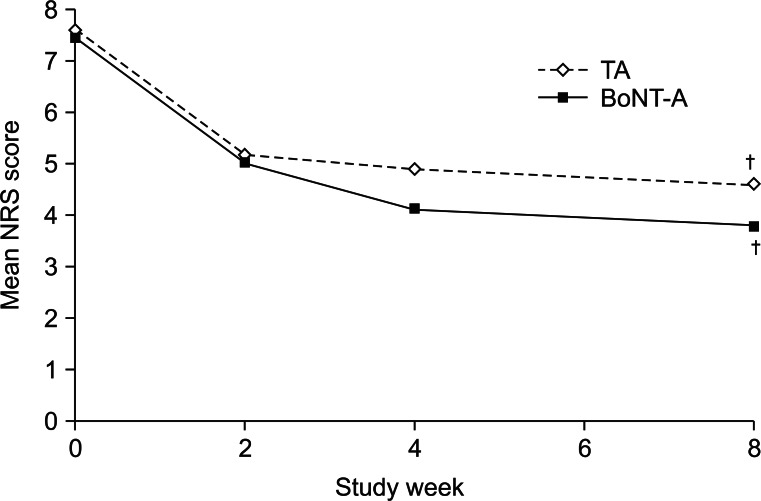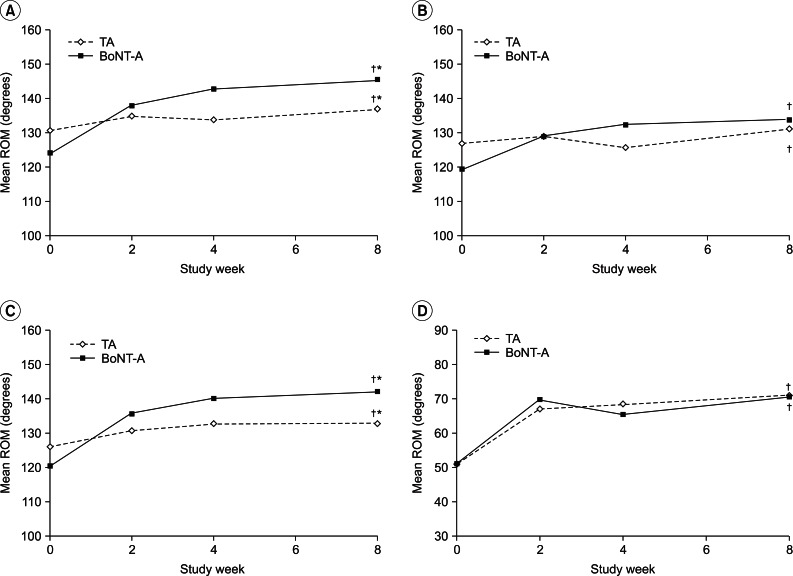Ann Rehabil Med.
2013 Apr;37(2):208-214. 10.5535/arm.2013.37.2.208.
A Comparison of the Short-Term Effects of a Botulinum Toxin Type A and Triamcinolone Acetate Injection on Adhesive Capsulitis of the Shoulder
- Affiliations
-
- 1Department of Rehabilitation Medicine, Gangneung Asan Hospital, University of Ulsan College of Medicine, Gangneung, Korea. song0805@gnah.co.kr
- 2Danam Rehabilitation Clinics, Seoul, Korea.
- 3Hanmaeum Sports Clinics, Seoul, Korea.
- 4Wooridul Spine Hospital, Seoul, Korea.
- 5Department of Physical Medicine and Rehabilitation, Seoul Rehabilitation Clinics, Seoul, Korea.
- KMID: 2165772
- DOI: http://doi.org/10.5535/arm.2013.37.2.208
Abstract
OBJECTIVE
To evaluate the short-term clinical effects of the intra-articular injection of botulinum toxin type A (BoNT-A) for the treatment of adhesive capsulitis.
METHODS
A prospective, controlled trial compared the effects of intra-articular BoNT-A (Dysport; 200 IU, n=15) with the steroid triamcinolone acetate (TA; 20 mg, n=13) in patients suffering from adhesive capsulitis of the shoulder. All patients were evaluated using a Numeric Rating Scale (NRS) of the pain intensity and a measurement of the range of motion (ROM) at baseline (before treatment) and at 2, 4, and 8 weeks post-treatment.
RESULTS
The NRS at 2 weeks (BoNT-A vs. TA; 5.0 vs. 5.2), 4 weeks (4.1 vs. 4.9) and 8 weeks (3.8 vs. 4.6) of both treatment groups were significantly lower than that measured at baseline (7.4 vs. 7.6). The ROM of patients' shoulders increased significantly from baseline in both treatment groups. There was no significant difference in the NRS of pain intensity or the ROM between the two groups. Reduction in the pain intensity score was maintained for 8 weeks post-injection in both groups. There were no significant adverse events in either treatment group.
CONCLUSION
The results suggest that there are no significant short-term differences between the intra-articular injections of BoNT-A and TA. Although BoNT-A has a high cost, it may be used as a safe alternative of TA to avoid the steroid-induced side effects or as a second-line agent, for patients who have failed to respond to the current treatments.
MeSH Terms
Figure
Reference
-
1. Grey RG. The natural history of "idiopathic" frozen shoulder. J Bone Joint Surg Am. 1978; 60:564. PMID: 670287.
Article2. Bunker TD, Anthony PP. The pathology of frozen shoulder: a dupuytren-like disease. J Bone Joint Surg Br. 1995; 77:677–683. PMID: 7559688.
Article3. Shah N, Lewis M. Shoulder adhesive capsulitis: systematic review of randomised trials using multiple corticosteroid injections. Br J Gen Pract. 2007; 57:662–667. PMID: 17688763.5. Hand GC, Athanasou NA, Matthews T, Carr AJ. The pathology of frozen shoulder. J Bone Joint Surg Br. 2007; 89:928–932. PMID: 17673588.
Article6. Milgrom C, Novack V, Weil Y, Jaber S, Radeva-Petrova DR, Finestone A. Risk factors for idiopathic frozen shoulder. Isr Med Assoc J. 2008; 10:361–364. PMID: 18605360.7. Tillander B, Franzen LE, Karlsson MH, Norlin R. Effect of steroid injections on the rotator cuff: an experimental study in rats. J Shoulder Elbow Surg. 1999; 8:271–274. PMID: 10389085.
Article8. Berardelli A, Gilo F, Curra A. Brin MF, Hallett M, Jankovic J, editors. Effects of botulinum toxin type A on central nervous system function. Scientific and therapeutic aspects of botulinum toxin. 2002. Philadelphia: Lippincott William & Wilkins;p. 171–177.9. Cui M, Khanijou S, Rubino J, Aoki KR. Subcutaneous administration of botulinum toxin a reduces formalin-induced pain. Pain. 2004; 107:125–133. PMID: 14715398.
Article10. Jeynes LC, Gauci CA. Evidence for the use of botulinum toxin in the chronic pain setting: a review of the literature. Pain Pract. 2008; 8:269–276. PMID: 18503628.11. Knutson GA. The role of the gamma-motor system in increasing muscle tone and muscle pain syndromes: a review of the Johansson/Sojka hypothesis. J Manipulative Physiol Ther. 2000; 23:564–572. PMID: 11050614.12. Mense S. Neurobiological basis for the use of botulinum toxin in pain therapy. J Neurol. 2004; 251(Suppl 1):I1–I7. PMID: 14991335.
Article13. Rosales RL, Arimura K, Takenaga S, Osame M. Extrafusal and intrafusal muscle effects in experimental botulinum toxin-A injection. Muscle Nerve. 1996; 19:488–496. PMID: 8622728.
Article14. Welch MJ, Purkiss JR, Foster KA. Sensitivity of embryonic rat dorsal root ganglia neurons to Clostridium botulinum neurotoxins. Toxicon. 2000; 38:245–258. PMID: 10665805.
Article15. Goyal N. Intra-articular knee joint Botox injection for chronic osteoarthritic pain. Anaesth Intensive Care. 2008; 36:123. PMID: 18326148.16. Mahowald ML, Singh JA, Dykstra D. Long term effects of intra-articular botulinum toxin A for refractory joint pain. Neurotox Res. 2006; 9:179–188. PMID: 16785116.
Article17. Singh JA, Mahowald ML. Intra-articular botulinum toxin A as an adjunctive therapy for refractory joint pain in patients with rheumatoid arthritis receiving biologics: a report of two cases. Joint Bone Spine. 2009; 76:190–194. PMID: 18952480.
Article18. Singh JA, Mahowald ML, Kushnaryov A, Goelz E, Dykstra D. Repeat injections of intra-articular botulinum toxin a for the treatment of chronic arthritis joint pain. J Clin Rheumatol. 2009; 15:35–38. PMID: 19131763.
Article19. Hernanz A, De Miguel E, Romera N, Perez-Ayala C, Gijon J, Arnalich F. Calcitonin gene-related peptide II, substance P and vasoactive intestinal peptide in plasma and synovial fluid from patients with inflammatory joint disease. Br J Rheumatol. 1993; 32:31–35. PMID: 7678534.
Article20. Buma P, Verschuren C, Versleyen D, Van der Kraan P, Oestreicher AB. Calcitonin gene-related peptide, substance P and GAP-43/B-50 immunoreactivity in the normal and arthrotic knee joint of the mouse. Histochemistry. 1992; 98:327–339. PMID: 1283163.
Article21. Alstergren P, Appelgren A, Appelgren B, Kopp S, Lundeberg T, Theodorsson E. Co-variation of neuropeptide Y, calcitonin gene-related peptide, substance P and neurokinin A in joint fluid from patients with temporomandibular joint arthritis. Arch Oral Biol. 1995; 40:127–135. PMID: 7540832.
Article22. Kido MA, Kiyoshima T, Kondo T, Ayasaka N, Moroi R, Terada Y, et al. Distribution of substance P and calcitonin gene-related peptide-like immunoreactive nerve fibers in the rat temporomandibular joint. J Dent Res. 1993; 72:592–598. PMID: 7680675.23. Hanesch U, Heppelmann B, Schmidt RF. Substance P- and calcitonin gene-related peptide immunoreactivity in primary afferent neurons of the cat's knee joint. Neuroscience. 1991; 45:185–193. PMID: 1721692.
Article24. Zhibo X, Miaobo Z. Botulinum toxin type A affects cell cycle distribution of fibroblasts derived from hypertrophic scar. J Plast Reconstr Aesthet Surg. 2008; 61:1128–1129. PMID: 18555763.
Article25. Brue S, Valentin A, Forssblad M, Werner S, Mikkelsen C, Cerulli G. Idiopathic adhesive capsulitis of the shoulder: a review. Knee Surg Sports Traumatol Arthrosc. 2007; 15:1048–1054. PMID: 17333122.
Article26. Ombregt L, Bisschop P, Veer HJ. A system of orthopaedic medicine. 2003. 2nd ed. Edinburgh: Churchill Livingstone.27. Tveita EK, Ekeberg OM, Juel NG, Bautz-Holter E. Range of shoulder motion in patients with adhesive capsulitis; intra-tester reproducibility is acceptable for group comparisons. BMC Musculoskelet Disord. 2008; 9:49. PMID: 18405388.
Article28. Schaible HG, Ebersberger A, Von Banchet GS. Mechanisms of pain in arthritis. Ann N Y Acad Sci. 2002; 966:343–354. PMID: 12114291.
Article29. Namazi H, Torabi S. Novel use of botulinum toxin to ameliorate arthrofibrosis: an experimental study in rabbits. Toxicol Pathol. 2007; 35:715–718. PMID: 17763285.
Article30. Depalma AF. Loss of scapulohumeral motion (frozen shoulder). Ann Surg. 1952; 135:193–204. PMID: 14903846.
Article31. Kong KH, Neo JJ, Chua KS. A randomized controlled study of botulinum toxin A in the treatment of hemiplegic shoulder pain associated with spasticity. Clin Rehabil. 2007; 21:28–35. PMID: 17213238.
- Full Text Links
- Actions
-
Cited
- CITED
-
- Close
- Share
- Similar articles
-
- Treatment of Adhesive Capsulitis with Steroid Injection Followed by Hyaluronic Acid Injection
- The Effect of Intraarticular Injection of Hyaluronic Acid and Steroid in Adhesive Capsulitis of Shoulder
- Adhesive Capsulitis of the Shoulder
- The Comparison of Therapeutic Effect of Shoulder Pain with Simple and Mixed Type in Patients with Adhesive Capsulitis
- Updates on Intra-articular Corticosteroid Injection for the Treatment of Adhesive Capsulitis



